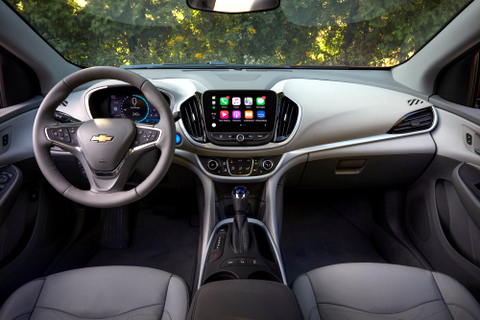Get it While You Can
During the very week I was testing the 2019 Chevrolet Volt plug-in hybrid, GM announced that it was closing the Detroit-Hamtramck plant where it’s built, in March, 2019. That’s unwelcome holiday news for the plant workers, but reflects business reality—the Volt has never been a big seller. It may be good news, though, if GM does what it promises and doubles its investment in the all-electric vehicles it will introduce in the next decade.
The Volt is a hatchback that looks like a sedan, which puts it at a disadvantage in the American car market, where crossovers are becoming king. Now in the fourth year of its redesigned and improved second generation, the Volt, despite its high-tech powertrain, is the latest in GM’s long history of compacts, from the Corvair to the Chevy II, Nova, Cavalier and Cobalt.

Electric vehicles entered the automotive marketplace at the beginning of this decade, when Nissan’s all-electric Leaf and GM’s first-generation Volt arrived with big fanfare. While the Leaf jumped into the EV market with both feet, the Volt was a calculated compromise. Based on research that said that most car owners don’t drive more than about 40 miles a day, GM provided the Volt with a compact battery pack and included a small gasoline engine as a range extender.
Unlike a traditional hybrid, the car was essentially an all-electric powered car, but when it ran out of juice, the small engine kicked in to charge the battery, not to drive the wheels. You could use this arrangement to go hundreds of miles, so the range anxiety of the Leaf’s 73-mile range was not a factor.
An All-Electric Commute

My test Pacific Blue Metallic 2019 Chevrolet Volt proved the point. My 18-mile-each-way commute was easily handled, using the ChargePoint Level 2 (240-volt) chargers at work and household current at home overnight. I didn’t take any long weekend trips, so during my week-long test I used exactly zero gasoline. Chevrolet claims that “on average, new owners of the Volt travel 1,100 miles between fill-ups with regular charging (based on 2016-2018 model-year owners.)”
The Volt comes in two levels—LT and Premier. My Premier tester had the upgraded features you’d expect and felt much plusher than the first-generation car. The swirls of matte-finish plastic and tasteful chrome accents convey motion and excitement, while the colorful dash panels provide all the information you need to monitor your driving.
A Better Charge
First-gen Volts charged on Level 2 at 3.6 kilowatts (kW) per hour, but for 2019, only the LT soldiers on with that, while the Premier gets a 7.2-kW system that cuts charging a drained battery from 4.5 to 2.25 hours. Charging at home on 120-volt current, using the supplied cord, takes around 13 hours—approximately overnight—depending on ambient temperature.

Much of driving an EV efficiently is managing your acceleration and braking, and a floating ball display lets you see at a glance whether you’re charging or discharging the battery. You get current and cumulative range projections and can monitor how much you have in both your battery and fuel tank.
The 2019 Chevrolet Volt is a hatchback that looks like a sedan. You can fit plenty in the rear, for that reason. Rear seat accommodations are not overly generous, however, and a center console limits the middle position to a car seat (a belt is provided). The Volt is lower and smaller inside than its all-electric Bolt EV sibling, even though it is stretches longer nose to tail.
Smooth Electric Driving
Driving electric is a joy—it’s smooth and quiet. The Volt’s motor provides 149 horsepower versus the Bolt EV’s 200, but 294 pounds-feet of torque enables exuberant driving without undue drama in the 3,549-pound car. The only sound is a high-tech whine programmed in to project at low speeds to warn oblivious pedestrians.

EPA range numbers are 53 miles for electric only and 420 miles total with a full battery and gas tank. Fuel economy stats are 106 MPGe for electric only and 42 mpg for gasoline only (combined city and highway). EPA Green scores are a perfect 10 for Greenhouse Gas but a 5 for Smog. If you don’t use the gas engine much, you’ll likely do better.
You can extend your range by selecting Eco for the climate system instead of Max. I used Max because it was cool during my test week. You can also increase the car’s electric regeneration by setting the transmission in “L,” as in the Bolt EV. This enables one-pedal driving, where pressing on the accelerator moves you forward and lifting your foot slows you down. Unlike in the Bolt, the regen drops off at the last couple of mph, requiring a touch to the brake pedal. With the lever in “D” the transmission behaves like a normal automatic. You can also use the left steering wheel paddle to add regeneration regardless of the L or D setting.
The Price Factor
Pricing is still a factor in electric cars, although the Volt’s lithium-ion battery pack is only 18.4 killowatt-hours vs. the Bolt’s 60. The LT starts at $34,395 and the Premier at $38,995 (both prices include shipping). My test car included the optional Driver Confidence Package ($990) with lane keep assist, forward automatic braking and other safety features. It also came with adaptive cruise control–Advanced ($595), which lets you set a following distance and use forward automatic braking (to maintain the distance).

My tester’s price came to $40,580, including shipping. Some state and federal rebates and tax credits apply, but the federal (larger) amount could go down soon, unless the rules are changed by Congress. Still, total incentives can lower the purchase price by as much as $10,000.
If you drive less than 50 miles a day and charge regularly, the 2019 Chevrolet Volt is a great choice for all-electric driving, with the option to take off wherever you want using the gasoline range extender. Of course, you will have to pay for an occasional oil change and carry the extra weight of an engine. But no other plug-in hybrid vehicle offers that large of an electric-only range. If you want a Volt, go grab it now.
Related Stories You Might Enjoy—Our Time with the Volt Through the Years
News: Say Farewell to the Chevrolet Volt
Road Test: 2017 Chevrolet Volt
Road Test: 2016 Chevrolet Volt
News: 2106 Chevrolet Volts Nabs Green Car of the Year
Personal: 2016 Chevrolet Volt Replaces Nissan Leaf
Road Test: 2014 Chevrolet Volt
Comparison: Prius Plug-in Hybrid vs. Chevrolet Volt
News: Chevrolet Volt & Open Ampera Voted 2012 EU Car of the Year
News: Early Owners Love Their Chevrolet Volts
News: Chevrolet Volt & Nissan Leaf Earn Highest Safety Ratings
News: Chevrolet Volt Wins Motor Trend Car of the Year
Test Drive: 2010 Chevrolet Volt
Disclosure:
Clean Fleet Report is loaned free test vehicles from automakers to evaluate, typically for a week at a time. Our road tests are based on this one-week drive of a new vehicle. Because of this we don’t address issues such as long-term reliability or total cost of ownership. In addition, we are often invited to manufacturer events highlighting new vehicles or technology. As part of these events we may be offered free transportation, lodging or meals. We do our best to present our unvarnished evaluations of vehicles and news irrespective of these inducements.
Our focus is on vehicles that offer the best fuel economy in their class, which leads us to emphasize electric cars, plug-in hybrids, hybrids and diesels. We also feature those efficient gas-powered vehicles that are among the top mpg vehicles in their class. In addition, we aim to offer reviews and news on advanced technology and the alternative fuel vehicle market. We welcome any feedback from vehicle owners and are dedicated to providing a forum for alternative viewpoints. Please let us know your views at publisher@cleanfleetreport.com.




















4 thoughts on “Road Test: 2019 Chevrolet Volt”